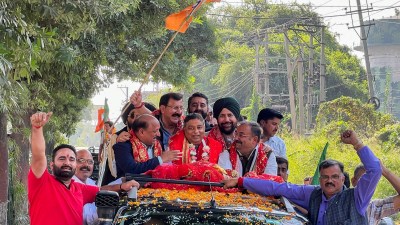
In at least seven instances, Justice Nagarathna took exception to “branding the judges of this Court of the yesteryears as doing a disservice to the Constitution”. Justice Sudhanshu Dhulia, too, who wrote a dissent, criticised the use of the phrase “Krishna Iyer doctrine” calling it “harsh, and could have been avoided.”
Story continues below this ad
While the sentence in question does not find mention in Justice Chandrachud’s final opinion, presumably removed after reflection, it adds to a new trend of judges engaging deeply with contrasting views in their rulings.
In the contentious same-sex marriage ruling in October 2023, Justice Chandrachud included a portion in his minority view titled, “Response to the opinion of Justice Ravindra Bhat.” Justice Bhat, too, in response, wrote “to clear the air or dispel any misunderstanding.”
In several instances, Justice Chandrachud questioned Justice Bhat’s views.
“In fact, Bhat, J’s reasoning deviates from the jurisprudence that this Court has developed on the interpretation of Article 15,” he wrote.
Story continues below this ad
In his opinion, Justice Bhat wrote: “Chief Justice further opines that the right to marriage is not fundamental. However, it is these very tangible and intangible benefits, the denial of which, according to the learned Chief Justice must inform the reading of a constitutional right to an abiding cohabitational union. In other words, the benefits of marriage, however fundamental to a fulfilling life do not make marriage itself a fundamental right, but they render the right to an abiding cohabitational union fundamental. I find it difficult to reconcile these.”
In the Indian Supreme Court, unlike the Supreme Court of the United States, judges usually have avoided engaging with each other’s point of view but only pen their own separate opinions.
In other Constitution bench opinions authored by Justice Nagarathna, including dissenting opinions, the judge has presented her views contrasting against the majority views in a “tabular form, for easy reference.”
Her seminal dissent in the demonetisation case in January 2023 has this imprint: “Question, as reframed by His Lordship; His Lordship’s views and My views.”
Story continues below this ad
Attempts to persuade other judges on the bench before writing the judgment are also not very common. For example, the US Supreme Court has a Justices’ Conference after oral arguments are concluded while in India, this largely depends on the judge heading the bench.
As former Chief Justice of India DY Chandrachud stitched through a narrow 4:3 majority in the ruling to determine the minority character of an educational institution, Justice Dipankar Dutta made it known through his dissenting opinion that there was no “meeting of minds” before or after the hearings.
“Here, a Constitution Bench of 7 (seven) Judges had apparently embarked on a voyage to interpret Article 30(1) of the Constitution navigating through considerable weight of materials without any physical or virtual meeting of the members of the Bench post-reservation of judgment, not to speak of meeting of minds, either immediately after hearing was concluded or even 9 (nine) months thereafter (either collectively or even in small groups of four-five) to explore which acceptable direction should the outcome sail,” Justice Dutta wrote.
“A common venue for a purposeful and effective dialogue where members of the bench could freely express their points of view, an attempt to share thoughts and to exchange opinions, a ‘give’ and ‘take’ of ideas, in true democratic spirit to build up a consensus — all these seem to have taken a backseat,” he added.









